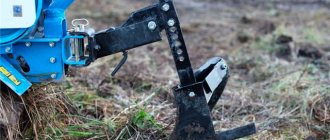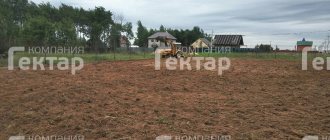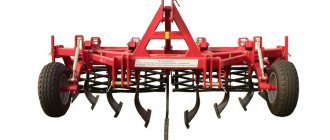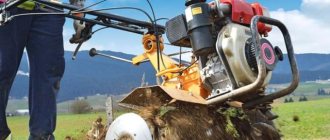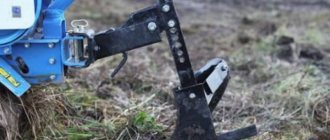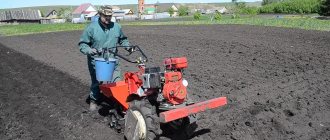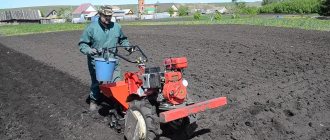The walk-behind tractor attracts small agricultural workers and owners of personal plots with its versatility and versatility. And, of course, not the least popular in the list of jobs he can do is plowing the plot. At first glance, there is no wisdom in this process, but this judgment is more than erroneous. Of course, if you set a goal, not only to do a high-quality job, but also to ensure long and trouble-free operation of the equipment.
What do we need?
In addition to the existing refilled unit, and by the way, almost any brand is suitable for this purpose, including the famous Neva, you should acquire special attachments in the form of lugs and a plow. As a rule, when they purchase a walk-behind tractor, they immediately take a full set of such additional accessories, which significantly simplifies its further work and makes it more diverse. Or, if the owner is not comfortable with a welding machine, these things can be done yourself, using, for example, plates of unnecessary metal, old car wheels, and an axle shaft with bearings and metal corners in the form of teeth.
If plowing with a walk-behind tractor is carried out on soft, already well-prepared soil, you can, in principle, do without lugs, but if you have to cultivate heavy soil, they are simply necessary, as they provide the necessary traction force for ideal traction. The heavier each lug, the more efficient the plowing will be, because otherwise the equipment will simply begin to slip. If even the installed disks do not provide the required weight, it can be increased with the help of additional weights installed on the structure.
Our services
- Plowing + cultivation
- Passing two or three times with an active rototiller until the plowed land turns into “fluff”!
- Grinding weed roots to a non-viable state
- Double cultivation until the soil turns to fluff
- Manual stretching and leveling of plowed soil
- Passing two or three times with an active rototiller until the plowed land turns into “fluff”!
- Manual site leveling
- Compacting the soil with a roller
- Sowing a lawn + 1000 rubles/1 hundred.
* minimum order amount is 10,000 rubles
We are ready to take on the most labor-intensive tasks in a country house, park or agricultural field:
- site clearing;
- garbage removal;
- plowing the land;
- leveling the area;
- weed control;
- elimination of pests, mole and snake holes;
- selection of rhizomes;
- comprehensive soil preparation for sowing crops or lawns, landscaping or construction work;
- home construction;
- site drainage;
- in winter, removing snow, ice and roofing;
At your request, we will turn an impenetrable windfall into an ideal lawn in just a few days of work!
We work throughout the Central region. For consultation and calculation of the cost of your order, call +7(985) 794-000-4 or leave a request in our online calculator.
How to plow properly with a walk-behind tractor: preparatory work
To plow the ground with a walk-behind tractor, you first need to decide on the track width. The generally accepted opinion is that it should be 55-60 cm. Next, you should drive the walk-behind tractor onto a flat piece of land, mount a replacement axle and ground hooks on the wheels (Attention: the replacement axle must be longer than the standard one!). After this, we begin to work directly with the plow. It is important to note that in its classic design, as a rule, there is a blade and a ploughshare.
The second is responsible for cutting the top layer of soil and moving it to the dump, and the first is responsible for turning over the mass fed to it and crushing it, followed by distribution along the furrow. And as a result, they achieve high-quality removal of weeds, as well as sufficient softening and oxygenation of the soil. Before work, the removable plow is assembled and hung on a special bracket provided in the walk-behind tractor; however, there is no need to tighten the connection tightly, because then we will have to adjust it. This stage is undoubtedly considered the most difficult and important, so we will analyze it in as much detail as possible:
- On a level area, wedges or even boards are placed under the unit, while simultaneously leveling the support leg using similar methods in such a way as to avoid its tilting towards the plow. In this case, the size of the stands is determined by the plowing depth (in spring the height is usually set at 10-20 cm, and in winter – at 20-25). The result is a stable, balanced structure of a walk-behind tractor with a plow;
- The slope of the plow is adjusted using adjusting bolts so that the heel (field board) runs parallel to the ground;
- The angle of the blade is adjustable. To do this, the unit is bent to the sides, removing the right wheel from the stand. In this case, it is important to slightly loosen the nuts securing the hitch with the hitch. Then carefully, slowly, turn the plow, achieving the optimal position for work. You can learn this by watching a thematic video; 4. The walk-behind tractor is freed from the stands, and the control handle is adjusted according to the operator’s height.
After all these operations, a control plowing of the garden with a walk-behind tractor can be carried out with a mandatory assessment of the depth of the furrow and the quality of the blade.
How to properly adjust a plow - advice from experienced craftsmen
When using a walk-behind tractor when plowing the land, it is necessary to correctly adjust the plow. This will ensure high efficiency of operations.
To set up the plow without difficulty, you must adhere to the following recommendations:
Adjusting the plow on a walk-behind tractor
- The walk-behind tractor must be slightly raised above the surface. The greater the plowing depth, the higher the stands should be;
- the hitch is installed strictly following the manufacturer’s recommendations;
- the plow is secured so that the edge of the ploughshare completely touches the soil;
- the plow drain is installed vertically, the beam is installed horizontally;
- At the base of the machine there is a lever that needs to be turned to the left. This allows the processing of unplowed strips;
- When turning the machine, you must ensure that the right wheel is opposite the finished furrow.
Rules for plowing land with a walk-behind tractor
Technologically, this process does not seem complicated, but it requires some adherence to generally accepted rules, which ensures maximum efficiency of the process and quality of the result.
- To begin with, the unit is installed on the edge of the field, the gear is set to maximum, and thus the walk-behind tractor is moved forward from itself towards the opposite edge of the site, holding it by the handles.
- At the end, a turn of 1800 is made and a similar pass is performed. It is important to remember that each subsequent ridge should be located a maximum of 10 cm from the previous one. This can be easily achieved by positioning the right lug in the middle of the blade of the nearest furrow.
- At first, it is recommended to go at low speed, checking in the first section the evenness of the line, the perpendicularity of the plow position to the ground and the depth of the result. If any of these parameters does not meet expectations, the work is interrupted and the equipment is adjusted accordingly. Ideally, it should not move jerkily, and the nose of the ploughshare should not be buried deep into the soil. Then the speed can be increased.
It is recommended to go through hard soil and virgin soil at least twice: first at a shallower depth of passage, and then at a greater depth.
Installation
Now the trestles can be removed and the plow can be assembled. It consists of installing a coupling mechanism called a hitch on the plow. The coupling mechanism is what is used to fix the plow to the towing device (TSU, towbar) of the unit. It can be of 2 types: universal and stationary. One coupling makes it possible to use a variety of objects (harrows, diggers, plows, etc.), and the other is needed to interface the adapter and device.
To make the installation of plowing equipment more comfortable, install the motorized equipment on supports, the function of which can be performed by stones, bricks or boards. Fixing the plow is very simple - the hitch for the unit has its own place on the towing device and is secured with a single pin. Many people believe that by firmly fixing the plow to the unit, things will go easier and faster. In practice, everything is quite the opposite. Because in the process of plowing, the implement is affected by forces concentrated vertically to the blade of the blade, there is a counteraction that tries to drag the entire walk-behind tractor to the side.
With “dead” fixation, the worker must exert force, literally crushing the unit into the soil - this is one of the most common mistakes. Therefore, it is necessary to leave a gap in the horizontal plane of approximately 5 degrees.
How to plow with a walk-behind tractor before winter and how is it useful?
As already mentioned, soil cultivation with a walk-behind tractor is usually carried out in two stages: in the fall, after all harvesting work on the site is completed, and in the spring, immediately before planting crops. You should not neglect preparing the land for winter, since, firstly, this will allow you to get rid of weeds, which, otherwise, will certainly cause a lot of trouble during the sowing season. And secondly, it allows you to loosen the soil before massive precipitation falls, providing moisture with proper drainage and not allowing dampness, mold and bacteria harmful to plants to linger.
In autumn, plowing time with a walk-behind tractor can vary greatly from region to region, and this is regulated, first of all, by weather conditions. It is important to finish it before frost, but immediately after harvesting there is no need to rush into it - you need to wait so that the weeds have time to ripen and germinate, then their destruction will be as effective as possible. In our area, as a rule, it is recommended to do this in November.
Processing with cutters
If you need to process a small area, it is recommended to use a walk-behind tractor with cutters, which are often included with it. During operation, the unit moves along the furrow in high gears. At the end of the section, the machine is turned 180° and the operation continues. During operation, it is necessary to ensure that the mechanism moves slowly at high speed of rotation of the cutters.
This tool should be placed horizontally, which prevents the formation of waves during plowing. This treatment is suitable for loosening the soil and removing weeds. But you should not carry out milling twice, which will negatively affect the properties of the soil.
Assembling a cutter for a walk-behind tractor
Some final tips and recommendations
As can be seen from the above, mastering plowing using walk-behind tractors is quite easy. But even experienced farmers have difficulties with this if they do not first take into account a number of important general nuances. First of all, errors can occur at the stage of selecting the appropriate equipment for a particular task. Thus, it is better to cultivate small areas (up to six acres) of land with light cultivators; in extreme cases, use only special cutters with a heavy walk-behind tractor. If the weight of the unit reaches a hundredweight, and its power is 10-12 hp, it can easily cope with twenty acres, but with a plow, or with a separately connected cultivator. Heavy models are designed to work on one or two hectares, and a full-fledged mounted plow is already used here. In addition, it is recommended to process edges and areas of complex geometry in any case using cutters.
Of course, the use of mini-equipment in agricultural work slightly increases the cost of production as a result, but when comparing labor and time costs, it becomes clear that this increase is more than justified.
Hitches
Plows and hillers are connected to the Salyut walk-behind tractor through the S-13 beam and the S-20 bracket using a universal hitch. It is better to make adjustments through the hitch.
Important! The obligatory coincidence of the longitudinal axis of the regulator and the walk-behind tractor, plus the vertical position of the beam, will help to configure the equipment in the best way.
To optimally set up a plow without a hitch, it is first advisable to align the minimum parameters for plowing depth and width.
Adjusting the plow without a hitch:
- Align the minimum parameters for plowing depth and width;
- The support triangle must be in a horizontal position;
- Adjust the field board parallel to the movement.
In the future, the plowing depth, depending on the soil, can be adjusted correctly using special holes on the plow stand or by changing the angle of inclination of the body.
Kinds
With the help of walk-behind tractors, you can perform different types of agricultural work. Depending on the size of the area being processed and the demand for equipment in different fields of activity, equipment is purchased in light, medium and heavy classes.
Lungs
This mini-equipment is often called a motor cultivator. Its power does not exceed 4 and a half horsepower, which is why it costs less than medium and large units. The cost of the lightweight model is from 12 to 22 thousand rubles. The advantages include the light weight of the monoblock and the accessibility of processing inconvenient areas due to the small grip of the cutter.
The downside is the rapid overheating of the low-power motor, which means that you will have to work with such equipment for a short time. In addition, the depth of the excavated soil is less than that of a heavy walk-behind tractor. In addition, light equipment does not have mounts for additional equipment.
Average
This vehicle has rear-wheel drive. Engine power – 5-12 horsepower. The device is capable of processing an area of half a hectare. The walk-behind tractor weighs from 50 to 70 kilograms, its cost is 30-40 thousand rubles. Most walk-behind tractors in this category can be used to mount a plow and other equipment.
This technique has 2 gears and is equipped with a front headlight. Compared to a heavy walk-behind tractor, a medium walk-behind tractor is more maneuverable, but its plowing depth does not exceed 12 cm. And this is unacceptable for planting some plants.


